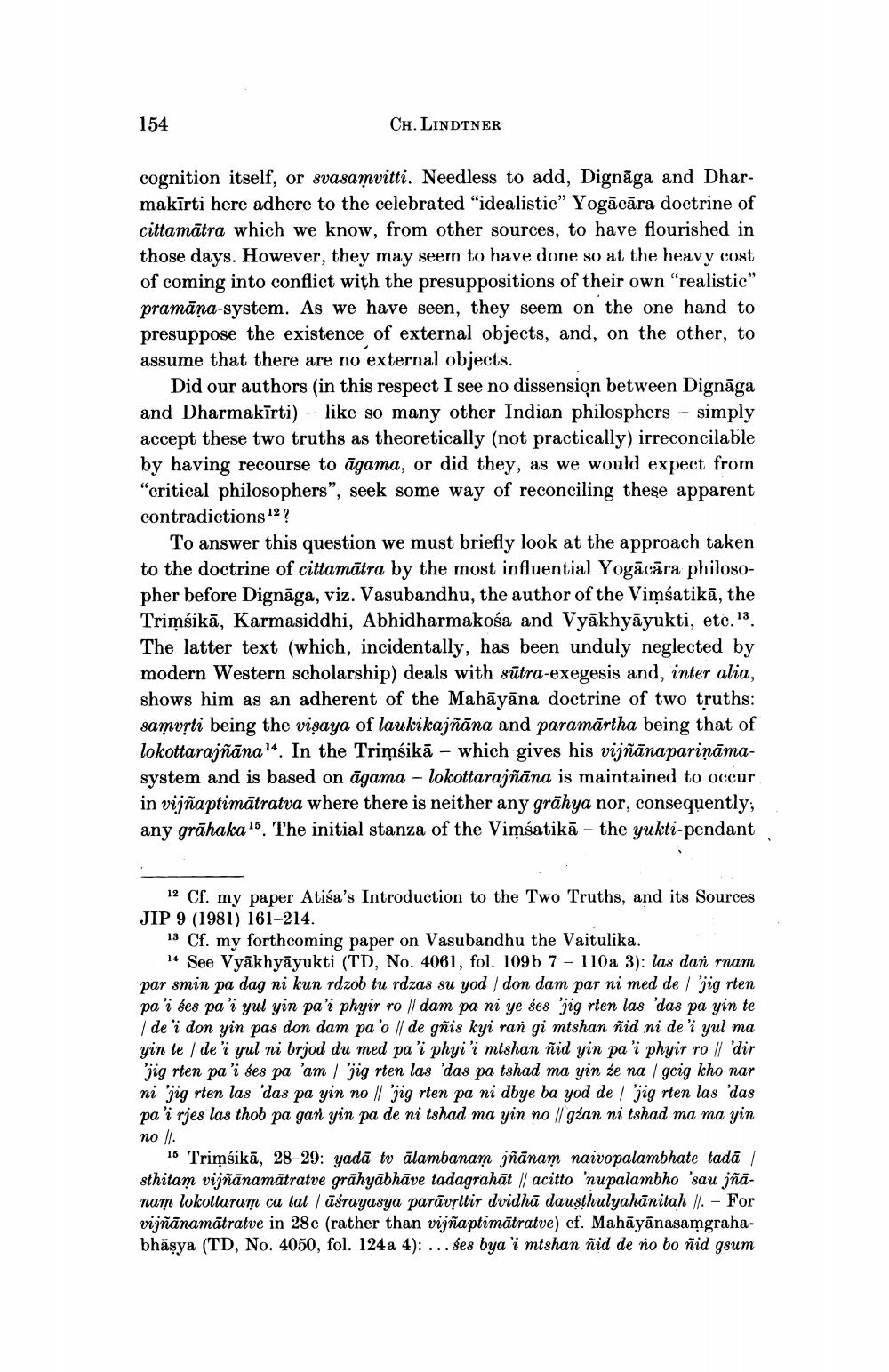Book Title: Marginalia To Dharmakirtis Pramanaviniscaya I II Author(s): Christian Lindtner Publisher: Christian Lindtner View full book textPage 6
________________ 154 CH. LINDTNER cognition itself, or svasamvitti. Needless to add, Dignaga and Dharmakirti here adhere to the celebrated "idealistic" Yogacara doctrine of cittamātra which we know, from other sources, to have flourished in those days. However, they may seem to have done so at the heavy cost of coming into conflict with the presuppositions of their own "realistic" pramana-system. As we have seen, they seem on the one hand to presuppose the existence of external objects, and, on the other, to assume that there are no external objects. Did our authors (in this respect I see no dissension between Dignaga and Dharmakīrti) like so many other Indian philosphers - simply accept these two truths as theoretically (not practically) irreconcilable by having recourse to agama, or did they, as we would expect from "critical philosophers", seek some way of reconciling these apparent contradictions 12? - To answer this question we must briefly look at the approach taken to the doctrine of cittamatra by the most influential Yogacara philosopher before Dignaga, viz. Vasubandhu, the author of the Vimsatikā, the Trimśikā, Karmasiddhi, Abhidharmakośa and Vyakhyāyukti, etc. 13. The latter text (which, incidentally, has been unduly neglected by modern Western scholarship) deals with sutra-exegesis and, inter alia, shows him as an adherent of the Mahāyāna doctrine of two truths: samurti being the visaya of laukikajñāna and paramartha being that of lokottarajñāna1. In the Trimśikā – which gives his vijñānapariņāmasystem and is based on agama - lokottarajñāna is maintained to occur in vijñaptimātratva where there is neither any grahya nor, consequently; any grahaka15. The initial stanza of the Vimsatikā - the yukti-pendant 12 Cf. my paper Atisa's Introduction to the Two Truths, and its Sources JIP 9 (1981) 161-214. 13 Cf. my forthcoming paper on Vasubandhu the Vaitulika. 14 See Vyakhyāyukti (TD, No. 4061, fol. 109b 7 110a 3): las dan rnam par smin pa dag ni kun rdzob tu rdzas su yod / don dam par ni med de / jig rten pa'i ses pa'i yul yin pa'i phyir ro || dam pa ni ye ses jig rten las 'das pa yin te / de 'i don yin pas don dam pa 'o // de gñis kyi ran gi mtshan ñid ni de 'i yul ma yin te / de 'i yul ni brjod du med pa 'i phyi 'i mtshan ñid yin pa 'i phyir ro || 'dir jig rten pa'i ses pa 'am / jig rten las 'das pa tshad ma yin źe na / gcig kho nar ni jig rten las 'das pa yin no // jig rten pa ni dbye ba yod de jig rten las 'das pa 'i rjes las thob pa gan yin pa de ni tshad ma yin no gźan ni tshad ma ma yin no //. 15 Trimśikā, 28-29: yadā tv ālambanam jñānam naivopalambhate tadā / sthitam vijñānamātratve grāhyābhāve tadagrahat || acitto 'nupalambho 'sau jñānam lokottaram ca tat / āśrayasya parāvṛttir dvidhā dauṣṭhulyahānitah ||. - For vijñānamātratve in 28c (rather than vijñaptimātratve) cf. Mahāyānasamgrahabhāṣya (TD, No. 4050, fol. 124a 4): ... ses bya'i mtshan ñid de no bo ñid gsumPage Navigation
1 ... 4 5 6 7 8 9 10 11 12 13 14 15 16 17 18 19 20 21 22 23 24 25 26 27
